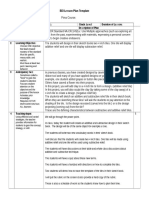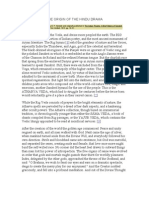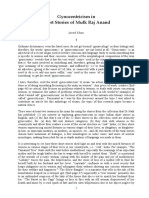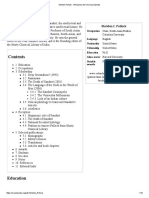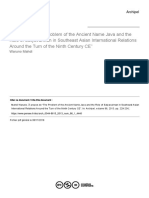Presentation of Women in Literature From Past To Present: Tippabhotla Vyomakesisri
Presentation of Women in Literature From Past To Present: Tippabhotla Vyomakesisri
Uploaded by
virtualvirusCopyright:
Available Formats
Presentation of Women in Literature From Past To Present: Tippabhotla Vyomakesisri
Presentation of Women in Literature From Past To Present: Tippabhotla Vyomakesisri
Uploaded by
virtualvirusOriginal Title
Copyright
Available Formats
Share this document
Did you find this document useful?
Is this content inappropriate?
Copyright:
Available Formats
Presentation of Women in Literature From Past To Present: Tippabhotla Vyomakesisri
Presentation of Women in Literature From Past To Present: Tippabhotla Vyomakesisri
Uploaded by
virtualvirusCopyright:
Available Formats
IOSR Journal Of Humanities And Social Science (IOSR-JHSS)
Volume 22, Issue 11, Ver. 9 (November. 2017) PP 18-20
e-ISSN: 2279-0837, p-ISSN: 2279-0845.
www.iosrjournals.org
Presentation of Women in Literature from Past to Present
Tippabhotla Vyomakesisri
M.A English literature, Osmania University
Abstract: Literacy has witnessed the role of women being evolved through ages. The following paper discusses
the evolution of women from ancient period to last ultra modern tech savaged period. The paper discuss the
feminism, the women problems and issues portrayed in the literature through the women centered roles. The
presentation of modern women by different female authors is discussed.
----------------------------------------------------------------------------------------------------------------------------- ----------
Date of Submission: 09-11-2017 Date of acceptance: 23-11-2017
----------------------------------------------------------------------------------------------------------------------------- ----------
I. INTRODUCTION
It is widely acknowledged that literature is the reflection of the society. Literature reflects the
perceptions and attitudes of the society. It portrays human life through characters, by their words and deeds
convey message for the purpose of instruction, information and delight. It is not wrong to say that literature is
witness to evolution of women through ages. The changing role of women in literature from the past to present
indicates the evolution of women and women empowerment.
From the ancient scriptures the status of women in India can be stated as equal to men. Veds like Rig
ved and Upanishads wrote about women sage and seer like Gargi and Matreyi. Classic Sanskrit literature begins
with epics and puranas. These serves as source of inspiration for writing to later poets, which also influenced in
shaping the women characters. The epic Ramayana and Mahabharata women characters have traits that had
their unfair moments of subjugation due to their gender. Women were considered less worthy than men and are
still objects used for the pleasure of men. The fact is that that these characters were curated and edited to suit the
needs of a patriarchal society. While Sita has been hailed for her sacrificing nature, Draupadi has been known
for her sharp oratory and comments and has been branded as being the centrifugal force that caused the
Mahabharata. Women in Greek Mythology show that women‟s rights were very limited and not allowed to
express much of their freedom. In ancient Greek life role of women was considered to be insignificant
compared to that of Greek men. Most of the popular plays in Greek have female characters complex, taking
upon the role of not only heroine, but also the role of villain and role of victim. The medieval literature show
women adhere to the narrow roles of wives, mothers. It is apparent from medieval literature restrictions placed
on women underwent significant changes, As the period went on, women gradually began to express more of
her opinions and had equal role in society.
II. WOMEN CHARACTERS IN LITERATURE
The ideal gender indicated that more passive qualities were feminine qualities, that is not to say that
they were qualities all women naturally possessed. However, in some circumstances it was acceptable women
who possessed more masculine qualities for example,Shakespeare's Kate inspired those around her to shun her.
Britomart, Spenser's heroine, though chaste and beautiful, was masculine as represented by her crossdressing as
a Knight and her magic spear in her adventure, a strong character who very actively fought as a knight and
saved lives. Shakespeare's famous Lady Macbeth is ambitious and driven, convincing her husband to kill the
king even after he had convinced himself not to. That she cannot bring herself to do the deed herself in
indicative of the weakness that comes with her being a woman-she can instigate the action, Speaking of
depiction of women in Indian poetry, Mahadevi Varma, a freedom-fighter, educationist and activist became the
mirror of Hindi poetry on women issues. She also wrote on issues of women's emancipation. She drew
inspiration for her subjects from traditional Hindu literature, which talked about liberating images.
Jai Shankar Prasad, depicted women as strong glorified. He became famous for his strong portrayals of women.
A popular verse from one of his most widely read poems, "Nari! tum kewal shraddha ho, Vishwas-rajat-nag-pal-
tal mein, Piyush strot si baha karo, Jeevan ki sundar samtal mein, which means, Oh woman! You are honour
personified, Under the silver mountain of faith, Flow you, like a river of ambrosia, On this beautiful earth.
In Indian regional poetry of 20th century, Poetess Amrita Pritam proved to be one of the leading voices. She
spoke of the aftermath of the India-Pakistan partition in the region of Punjab and the women oppressed in due
course in her Punjabi verses. Kamala Das paved way for a heart-rending style of feminine confessional poetry,
DOI: 10.9790/0837-2211091820 www.iosrjournals.org 18 | Page
Presentation of Women in Literature from Past to Present
in which a common theme was the exploration of the man-woman relationship. This style was subsequently
taken up by other women poets such as Gauri Deshpande and Chitra Narendran.
R.K.Narayan one among greatest Indian novelist. He wrote many novels such as, „Mr
Sampath‟(1949), „The Financial Expert‟(1952), „Waiting for the Mahatma‟(1955), „The Guide‟(1958), „The
Vendor of Sweets‟(1967), „The Painter of Signs‟(1977) etc. Most of his novels were on contemporary social
issues. His novel have women characters not as central characters but are often secondary characters like
mother, sister, friends, wife or foreigners. Susila, Rosie, Rukmini, Laxmi etc are his different female characters
in different novels, but they are not protesting women. These characters of women have the usual feminine
weakness and surrender themselves under the male domination. He portrays female characters who accept
marriage as their fate, about which they can do nothing but suffer patiently. These characters are ever shy and
demure as traditional Indian women should always be.
III. MODERN INDIAN WOMEN WRITER PROTRAY OF FEMALE CHARACTERS
A distinguished novelist Anita Desai novels main theme focused on women‟s quest for self identity.
All her women characters like Maya in „ Cry The Peacock‟, Uma in „ Fasting Feasting‟(1990), Lila in „ The
Village By The Sea: An Indian Family Story‟(1982), Bimla in „Clear Light Of Day‟(1980) long for freedom and
justice for their personality . Desai‟s women are often found themselves in harsh restless world dominated by
men. Her novels presented the image of a suffering woman preoccupied with her inner world, her sulking
frustration. Shashi Deshpande novels mostly portray clearly the middle-class Indian society. The heroine in her
first novel „The Dark Holds No Terror‟ (1980) Sarita play a great role for the unhappiness of her married life
In another novel „Roots and Shadow‟ (1983) central character is Indu who has rebel against the
orthodox traditions of village life. She prefers city life for it‟s conventions suitable for the „smart young set‟.
She return backs to her village after long gap of 12 years and realizes the resiliencies of the village life. Heroine
Jaya in „That long Silence‟, is an upper class house wife with two teenaged children. When her husband is
suspected of fraud, she was forced to shift into a small flat in a poor locality. Thus she feels her identity became
silenced under her silent suffering, so here the tragedy in her life comes due to the conflict of status between
inner secure of modernity and her poor and neglected circumstance. The novel is of course, this protagonist
Jaya‟s mental and emotional journey. All the female characters in her novels break out of the shackle of
classism and marry as per their wish but can‟t stand strong for long and finally makes themselves compelled to
surrender to the orthodox traditions of patriarchy.
Bharti Mukherjee‟s women in her novels are caught in the flux of patriarchal norms. They ultimately
crave for finding self identity, definition and liberation. The concept of feminism is justified in her novels as it
is a process to reform the society in favor of the female. She depicts a liquid society in her novels, ie a society in
flux. It is a society of constant flow, the flow of migrants, the flow of machines, flow of criminals, flow of
power structures, flow of people and commodities. Shobha De is one of the most feminist group writers who
voice in a strong modern and ultra modern way through her novels. Women are portrayed in a quite
unconventional and unorthodox way. Her novels deal with Love, romance, hatred and marital relationship, but
in an extravagant way. In fact she tries to portray the reality of metropolitan and cosmopolitan society. Her
women characters are ultra modern and westernized that they never belief in philosophy not even mythological
power distribution. Shobha De‟s women break all sorts of taboos and feel liberated. Her novels presents the
vital reality and creates aware of women miseries and injustices subjected to them by their counterparts in the
patriarchal society.
IV. CONCLUSION
Literature has witnessed the roles of women evolving through ages, most of the published writers were
men until recent times, therefore the portrayal of women was without doubt biased. Since the time of the first
explorers to the present, women‟s roles and portrayal in literature reflect the changes occurring historically for
women. The insignificance and oppression of women prior to the mid-19th century is related by the small roles
of females in literature. As women gained equality, the heroine continued to change. By studying these changes,
it is observed that not only do the characters embody the female identity, but also the heroines transform into the
new figures that women aspire to be.
REFERENCES
[1]. Arora, Neena. “An Analytical Study of Sisters.” The Fiction of Shobha De. Ed. Jaydipsinh Dodia. New
Delhi: Prestige 2000. 216-219. Print.
[2]. Barua, Gita. “Rise and Fall of a Star: A Study of Starry Nights.” The Fiction of Shobha De. Ed.
Jaydipsinh Dodia. New Delhi: Prestige. 2000. 174-179. Print.
[3]. K.K. Ruthven, Feminist literary studies: an introduction (Cambridge, 1990).
[4]. "Revisiting Shakespeare and Gender." Almasy, Rudolph. Daniel, Rebecca. Gerlach, Jeanne. 1996.
DOI: 10.9790/0837-2211091820 www.iosrjournals.org 19 | Page
Presentation of Women in Literature from Past to Present
[5]. “Oppressed like Us” The Tribune, 14 November 1987.
Shi rwadkar, Meena, "Indian English Women Novelists," Per spect ives an Indian Fict ion in English, ed.
English, ed. M.K. Naik, New Delhi : Abhinav Publicat ions, 1985.
[7]. Thomas, T. K. , "The Hindu Ethos - A Novelist ' s Per spect ive," Religion and Society, 20 December
1973, pp. 54-71 l96/gerlach.html
[8]. https://www.hinduismtoday.com/modules/smartsection/item.php?itemid=5566
IOSR Journal Of Humanities And Social Science (IOSR-JHSS) is UGC approved Journal with
Sl. No. 5070, Journal no. 49323.
Tippabhotla Vyomakesisri Presentation of Women in Literature from Past to Present.” IOSR
Journal Of Humanities And Social Science (IOSR-JHSS), vol. 22, no. 11, 2017, pp.18-20.
DOI: 10.9790/0837-2211091820 www.iosrjournals.org 20 | Page
You might also like
- Eei Lesson Plan Additive and Subtractive Tiles Semester 2Document4 pagesEei Lesson Plan Additive and Subtractive Tiles Semester 2api-317794487No ratings yet
- Influence of Western Music On The Film Music of Satyajit RayDocument2 pagesInfluence of Western Music On The Film Music of Satyajit RayAnupam RoyNo ratings yet
- International Journal on Multicultural Literature (IJML): Vol. 6, No. 2 (July 2016)From EverandInternational Journal on Multicultural Literature (IJML): Vol. 6, No. 2 (July 2016)No ratings yet
- Mystery, Magic and Morals: Looking at Themes and Ideas in Select Indian and Arabic LiteratureDocument5 pagesMystery, Magic and Morals: Looking at Themes and Ideas in Select Indian and Arabic LiteratureIJELS Research JournalNo ratings yet
- Duke University Press Twentieth Century LiteratureDocument23 pagesDuke University Press Twentieth Century LiteratureJoy Prokash RoyNo ratings yet
- Folk Tradition of Sanskrit Theatre A Study of Kutiyattam in Medieval Kerala PDFDocument11 pagesFolk Tradition of Sanskrit Theatre A Study of Kutiyattam in Medieval Kerala PDFanjanaNo ratings yet
- The Jataka BodhisattaDocument12 pagesThe Jataka BodhisattapsiNo ratings yet
- Mughal Miniatures - Akbari FinalDocument42 pagesMughal Miniatures - Akbari FinalWrishi BiswasNo ratings yet
- Corpusinscription - BharhutDocument350 pagesCorpusinscription - BharhutTrina MukhopadhyayNo ratings yet
- Cultural History of PallavasDocument11 pagesCultural History of PallavasSaptaparnaa SahaNo ratings yet
- PDFDocument4 pagesPDFအသွ်င္ ေကသရNo ratings yet
- Edgren VerbalRoots1878Document55 pagesEdgren VerbalRoots1878Марцис ГасунсNo ratings yet
- Kerala Culture Translation 16Document20 pagesKerala Culture Translation 16SONUNo ratings yet
- Love, Violence, and The Aesthetics of Disgust Śaivas and Jains in MedievalDocument61 pagesLove, Violence, and The Aesthetics of Disgust Śaivas and Jains in MedievalSomebodythatyouusedto_knowNo ratings yet
- Panchatantrapdf AA 76-2 PDFDocument65 pagesPanchatantrapdf AA 76-2 PDFSubraman Krishna kanth MunukutlaNo ratings yet
- Historical Overview of Indian TheatreDocument7 pagesHistorical Overview of Indian Theatretitiksha KumarNo ratings yet
- Histor of Sanskrit LiteratureDocument14 pagesHistor of Sanskrit Literatureswaminathan1No ratings yet
- Gunkel 2016 The Sanskrit Source of The Tocharian 4x25-Syllable MeterDocument18 pagesGunkel 2016 The Sanskrit Source of The Tocharian 4x25-Syllable MeterdcgunkelNo ratings yet
- The - Little - Clay - Cart - Mrcchakatika (Shudrak) PDFDocument229 pagesThe - Little - Clay - Cart - Mrcchakatika (Shudrak) PDFjayesh pethaniNo ratings yet
- Southern Mahabharata Recension and Brahmins MigrationsDocument147 pagesSouthern Mahabharata Recension and Brahmins Migrationsporridge23No ratings yet
- Bharatas Natyashastra PDFDocument8 pagesBharatas Natyashastra PDFClassical RevolutionaristNo ratings yet
- Bisschop, Peter and Yuko Yokochi. 2021. The Skandapurana Volume - VDocument314 pagesBisschop, Peter and Yuko Yokochi. 2021. The Skandapurana Volume - VShim JaekwanNo ratings yet
- Varuna and DhrtarāstraDocument21 pagesVaruna and Dhrtarāstracha072No ratings yet
- Sanskrit Vangmaya Ka Brihad Itihas: A Comprehensive History of Sanskrit LiteratureDocument3 pagesSanskrit Vangmaya Ka Brihad Itihas: A Comprehensive History of Sanskrit Literaturevishal sharma100% (1)
- Caste and Gender in Kamala DasDocument45 pagesCaste and Gender in Kamala DasAbhijith Ravi100% (1)
- Fem SaintsDocument329 pagesFem SaintsStanzin PhantokNo ratings yet
- Bomhard - The Two Meanings of The Pali Term "Pandaka"Document5 pagesBomhard - The Two Meanings of The Pali Term "Pandaka"Allan BomhardNo ratings yet
- Indian Theatre - Origins, Types & Characteristics PDFDocument4 pagesIndian Theatre - Origins, Types & Characteristics PDFFaruk R AhamedNo ratings yet
- ORIGIN OF GANESHA - M K DhavalikarDocument29 pagesORIGIN OF GANESHA - M K DhavalikarsosouravisNo ratings yet
- Origin of HIndu DramaDocument6 pagesOrigin of HIndu DramaManas Ranjan MishraNo ratings yet
- 07 - Chapter 1 PDFDocument13 pages07 - Chapter 1 PDFAnandNo ratings yet
- Brill - Ideology and Status of Sanskrit - 2015-07-29Document1 pageBrill - Ideology and Status of Sanskrit - 2015-07-29Gennaro MassaNo ratings yet
- File-4 (Chapter-3) PDFDocument136 pagesFile-4 (Chapter-3) PDFabc654No ratings yet
- A Short History of Malayalam LittDocument44 pagesA Short History of Malayalam LittSona Sebastian100% (1)
- The University of Chicago PressDocument29 pagesThe University of Chicago PressSergio MendesNo ratings yet
- Options Basics 01Document52 pagesOptions Basics 01sam2004No ratings yet
- Archetypes in Indian LiteratureDocument5 pagesArchetypes in Indian Literaturewordsmith01No ratings yet
- Gynocentricismin Short Storiesof Mulk Raj AnandDocument28 pagesGynocentricismin Short Storiesof Mulk Raj AnandNiban Ilawur100% (1)
- Vakrokti and DhvaniDocument13 pagesVakrokti and Dhvanivasya10No ratings yet
- Sita: My Story: Odisha Review ISSN 0970-8669Document5 pagesSita: My Story: Odisha Review ISSN 0970-8669FreshflowerNo ratings yet
- Indian English 1Document225 pagesIndian English 1Sravan Reddy100% (1)
- Aucitya in Poetry PDFDocument42 pagesAucitya in Poetry PDFjerryNo ratings yet
- Sheldon PollockDocument10 pagesSheldon PollockstevenspillkumarNo ratings yet
- Tracing Vaishnava Strains in Tagore - 1 July 2011Document27 pagesTracing Vaishnava Strains in Tagore - 1 July 2011Lubna MariumNo ratings yet
- 13 - Chapter 5 PDFDocument53 pages13 - Chapter 5 PDFNabagram Hiralal Paul CollegeNo ratings yet
- Buddhacharita 12Document4 pagesBuddhacharita 12Sara RussellNo ratings yet
- Oral Literature of Kashmiri LanguageDocument70 pagesOral Literature of Kashmiri LanguageabujeNo ratings yet
- Literary Criticism Essentials: by Shabnam KaurDocument86 pagesLiterary Criticism Essentials: by Shabnam KaurEdificator BroNo ratings yet
- A 17th Century Mongol Mañjuśrīnāmāśa Gīti With CommentaryDocument21 pagesA 17th Century Mongol Mañjuśrīnāmāśa Gīti With CommentaryTimNo ratings yet
- Origin and Pecularities of Jainism: Chapter OneDocument16 pagesOrigin and Pecularities of Jainism: Chapter OneNikhil ThomasNo ratings yet
- History of The Pallavas of KanchiDocument281 pagesHistory of The Pallavas of KanchiSharmalan Thevar100% (5)
- BEGC-101: Indian Classical LiteratureDocument48 pagesBEGC-101: Indian Classical LiteratureSammyNo ratings yet
- SamskaraDocument25 pagesSamskaraMohammed MusthafaNo ratings yet
- Mund Tripti Kalida's Shakuntala and The Doctrine of RasaDocument121 pagesMund Tripti Kalida's Shakuntala and The Doctrine of RasaLjubisa MaticNo ratings yet
- B.A. Hons. English Semester - I PDFDocument28 pagesB.A. Hons. English Semester - I PDFBabyNo ratings yet
- Kavya-Alankara-Vivrti - Sreenivasarao's BlogsDocument10 pagesKavya-Alankara-Vivrti - Sreenivasarao's BlogsSovan ChakrabortyNo ratings yet
- Max Muller - Missionary or ScholarDocument7 pagesMax Muller - Missionary or ScholarTukaram Chinchanikar100% (2)
- Understanding Book Review - Using "Khirer Putul - The Doll of Condensed Milk" by Abanindranath Tagore (Translation by Amita Ray) As A Practical ExampleDocument11 pagesUnderstanding Book Review - Using "Khirer Putul - The Doll of Condensed Milk" by Abanindranath Tagore (Translation by Amita Ray) As A Practical ExampledebdyutiNo ratings yet
- Indo-European LanguagesDocument2 pagesIndo-European Languagesbinqiangliu100% (1)
- Powerview 3.0 Generic Tables and Fields Page 1 of 7: Field Name Field Description Data Type Relationship ClientsDocument7 pagesPowerview 3.0 Generic Tables and Fields Page 1 of 7: Field Name Field Description Data Type Relationship ClientsNéstor Raúl Pineda JaraNo ratings yet
- M18 Exponential and Logarithmic FunctionsDocument166 pagesM18 Exponential and Logarithmic FunctionsOlivaa WilderNo ratings yet
- TeamViewer API DocumentationDocument40 pagesTeamViewer API DocumentationjonasoutlawNo ratings yet
- Lincoln at GettysburgDocument8 pagesLincoln at GettysburgCharles Garrick FlanaganNo ratings yet
- Runway RubricDocument2 pagesRunway Rubricapi-253897352No ratings yet
- Rust Programming Language - A Comprehensive Beginner - S Guide To RustDocument256 pagesRust Programming Language - A Comprehensive Beginner - S Guide To RustMohammad Haroon Waseem100% (1)
- LmfitDocument117 pagesLmfitVíctor KNo ratings yet
- Mapeh 6 - Q4 - W1 DLLDocument8 pagesMapeh 6 - Q4 - W1 DLLJohn Harries RillonNo ratings yet
- Math Talks - What's Missing - (Zorbit)Document22 pagesMath Talks - What's Missing - (Zorbit)Calin BNo ratings yet
- Net 2017 P 1Document22 pagesNet 2017 P 1Sathya 892No ratings yet
- Ramesh ResumeDocument2 pagesRamesh ResumeInternshipsNo ratings yet
- 3 STemWinDocument36 pages3 STemWinChayma Ben ZekriNo ratings yet
- Techopedia Explains: Common Object Request Broker Architecture (CORBA)Document1 pageTechopedia Explains: Common Object Request Broker Architecture (CORBA)incy vincyNo ratings yet
- 3 IDOP 2024 SEMINAR PPT Five Spritual Benefits of PrayerDocument30 pages3 IDOP 2024 SEMINAR PPT Five Spritual Benefits of PrayerJerry II TabelismaNo ratings yet
- Harwood Study GuideDocument26 pagesHarwood Study Guidetiffany100% (3)
- Arabic Khuthba PDFDocument4 pagesArabic Khuthba PDFSadman Sakib KhanNo ratings yet
- Type of SpeechDocument13 pagesType of Speechanon_398691653No ratings yet
- Present Simple - BookletDocument8 pagesPresent Simple - BookletNicole MichelNo ratings yet
- CH 1 Digital Logic DesignDocument46 pagesCH 1 Digital Logic DesignGowtham KrishnaBBENo ratings yet
- (The New Middle Ages) Nizar F. Hermes (Auth.) - The (European) Other in Medieval Arabic Literature and Culture - Ninth-Twelfth Century AD-Palgrave Macmillan US (2012) PDFDocument252 pages(The New Middle Ages) Nizar F. Hermes (Auth.) - The (European) Other in Medieval Arabic Literature and Culture - Ninth-Twelfth Century AD-Palgrave Macmillan US (2012) PDFcevadhanNo ratings yet
- Val Integ 1 NazarenoDocument12 pagesVal Integ 1 Nazarenoapi-651394813No ratings yet
- DLD Lab ManualDocument35 pagesDLD Lab ManualHrishikesh Garud100% (2)
- CTX104063 - Explaining and Changing The Citrix XML ServiceDocument3 pagesCTX104063 - Explaining and Changing The Citrix XML Servicecumfly60No ratings yet
- Education in The Philippines Evolved From Early Settlers To The PresentDocument5 pagesEducation in The Philippines Evolved From Early Settlers To The PresentRichmond AriolaNo ratings yet
- Paper Title (Use Style: Paper Title) : Subtitle As Needed (Paper Subtitle)Document4 pagesPaper Title (Use Style: Paper Title) : Subtitle As Needed (Paper Subtitle)Agung SuryaputraNo ratings yet
- Project 2Document11 pagesProject 2Rahul GoyalNo ratings yet
- Arlo Versus Mahdi - JavaDocument7 pagesArlo Versus Mahdi - JavaYogacarabhumiNo ratings yet
- InheritanceDocument35 pagesInheritanceAK FREEZENo ratings yet
- G-5 Prose - July - Meeting Miss Trotwood - P-2Document3 pagesG-5 Prose - July - Meeting Miss Trotwood - P-2Mubaraka FanuswalaNo ratings yet
